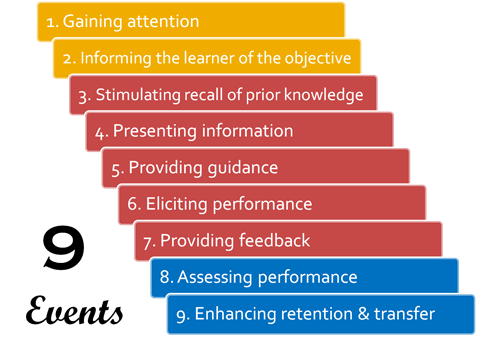- by Lon Naylor
These 9 Principles of Instruction Can Help Plan your Video Tutorials
When you are creating a tutorial or an e-learning course, there is a certain flow that the course must have in order for an adult to stay engaged and motivated to complete it. I learned a lot of theories about this back in graduate school where I studied adult learning in field called. Instructional Technology.
The most useful instruction that I learned was to follow a systematic approach to instructional design and training created by Robert Gagne. He created a nine-step process called the “Events of Instruction”, which I still use to this day when designing video courses for our Learn Camtasia website and for my clients.
Here are the nine events that must occur in your training video in order for learning to take place:

Now let me elaborate a bit on what each of these events really mean.
1. Gain attention
In order for any learning to take place, you must first capture the attention of the student. A video tutorial that begins with an animated title screen sequence accompanied by sound effects or music startles the senses with auditory or visual stimuli. An even better way to capture students’ attention is to start each lesson with a thought-provoking question or interesting fact. Curiosity motivates students to learn.
2. Inform learners of objectives
Early in each video lesson students should encounter a list of learning objectives. This initiates the internal process of expectancy and helps motivate the learner to complete the lesson. These objectives should form the basis for assessment and possible certification as well. Typically, learning objectives are presented in the form of “Upon completing this lesson you will be able to…”
3. Stimulate recall of prior learning
Associating new information with prior knowledge can facilitate the learning process. It is easier for learners to encode and store information in long-term memory when there are links to personal experience and knowledge. A simple way to stimulate recall is to ask questions about previous experiences, an understanding of previous concepts, or a body of content.
4. Present the content
This event of instruction is where the new content is actually presented to the learner. Content should be chunked and organized meaningfully, and typically is explained and then demonstrated. To appeal to different learning styles, a variety of media should be used if possible, including text, graphics, audio narration.
5. Provide “learning guidance”
To help learners encode information for long-term storage, additional guidance should be provided along with the presentation of new content. Guidance strategies include the use of examples, non-examples, case studies, graphical representations, mnemonics, and analogies.
6. Elicit performance (practice)
In this event of instruction, the learner is required to practice the new skill or behavior. Eliciting performance provides an opportunity for learners to confirm their correct understanding, and the repetition further increases the likelihood of retention.
7. Provide feedback
As learners practice new behavior it is important to provide specific and immediate feedback of their performance. Unlike questions in a post-test, exercises within tutorials should be used for comprehension and encoding purposes, not for formal scoring. Additional guidance and answers provided at this stage are called formative feedback.
8. Assess performance
Upon completing instructional modules, students should be given the opportunity to take a post-test or final assessment. This assessment should be completed without the ability to receive additional coaching, feedback, or hints. Mastery of material, or certification, is typically granted after achieving a certain score or percent correct. A commonly accepted level of mastery is 80% to 90% correct.
9. Enhance retention and transfer to the job
Determining whether or not the skills learned from a training program are ever applied back on the job often remains a mystery to training managers – and a source of consternation for senior executives. Effective training programs have a “performance” focus, incorporating design and media that facilitate retention and transfer to the job. The repetition of learned concepts is a tried and true means of aiding retention, although often disliked by students. (There was a reason for writing spelling words ten times as grade school student.) Creating electronic or online job-aids, references, templates, and wizards are other ways of aiding performance.
Applying Gagne’s nine-step model to any training program is the single best way to ensure an effective learning program. A video course that is filled with glitz or that provides unlimited access to Web-based documents is no substitute for sound instructional design.
————————————————————————————————
If you would like to learn more about how to use these 9 events of instruction to design really effective video training courses please take a look at my course Video Tutorial Profits. I’m re-launching it this week with a special Implementation webinar on May 10th to help students get their videos completed.
